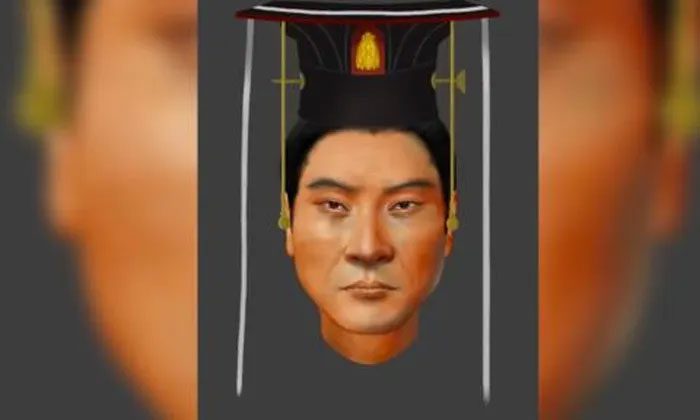Emperor Wu ruled China as part of the Northern Zhou dynasty from 560 to 580 AD and is noted for unifying the northern part of ancient China during a particularly chaotic period.
Archaeologists discovered his tomb in northwest China in 1996. In a study published on March 28 in the journal Current Biology, researchers analyzed genetic material from his remains, which included a nearly complete skull. They gathered information about his appearance, health, and ancestry.
This emperor belonged to a relatively less-studied nomadic group known as the Xianbei, who lived in what is now Mongolia and northern and northeastern China. The analysis of sequenced DNA showed that Emperor Wu had brown eyes, black hair, and skin that ranged from dark to neutral tones.
Shaoqing Wen, a co-author of the study and an associate professor at Fudan University in Shanghai, stated, “According to some scholars, the Xianbei were a people with ‘strange’ appearances, such as thick beards, high noses, and blonde hair. Our analysis shows that Emperor Wu had facial features typical of East or Northeast Asian individuals.”
The authors hope that ancient DNA can shed light on the cause of Emperor Wu’s death. According to the research, he died suddenly at the age of 36. Explanations for his death provided in historical texts include illness and the possibility of being intentionally poisoned by others.

Reconstructed face of Emperor Wu of Northern Zhou.
The research team could not find any conclusive evidence regarding the reasons for his death. However, researchers noted that they discovered genetic predispositions to stroke, which could explain some symptoms that historians attributed to Emperor Wu: drooping eyelids, blindness, and affected gait.
Archaeologists are increasingly employing ancient DNA techniques to extract information from bones, teeth, artifacts, and cave dust.
The research team utilized genetic information from the remains, including Emperor Wu’s skull, to visualize what he might have looked like, creating a 3D facial reconstruction of a relatively unknown historical figure.
Tobias Houlton, a lecturer in craniofacial identification and forensic imaging at the University of Dundee, who has studied facial reconstructions of historical remains, commented, “The study… provides fascinating insights into the historical figure of Emperor Wu with a fairly accurate facial presentation that looks convincingly realistic.”
“It is particularly unpredictable to ascertain color details (skin, hair, and eye color) based solely on the skeleton, making genetic analysis a profound tool,” the expert emphasized.
However, the study did not provide enough detail on other morphological variables such as skin thickness, muscle and fat surrounding the facial bones, eye position and projection, eyebrow shape, nose width, and lip height—factors that could have been incorporated into the facial reconstruction, Houlton noted.
Jeong Hoongwon, an associate professor at the School of Biological Sciences at Seoul National University (South Korea), remarked that what is more interesting than the emperor’s appearance is his Xianbei ancestry. Jeong, who did not participate in the new study, has researched the Huns, a separate nomadic empire that pushed China to build the Great Wall.
Genetic analysis indicates that Emperor Wu married a Han ethnic woman.
“I think it’s important to understand the elite group he belonged to, which arose from the unification of elite groups from the Xianbei and local Han, rather than from him alone,” Jeong remarked to CNN. “This group has rarely been studied in genetics, and this research provides one of the first cases of such.”
Bryan Miller, an assistant professor of Central Asian art and archaeology at the University of Michigan (USA), noted that Emperor Wu ruled during a period of Chinese history often referred to as the “Era of Chaos”, with successive dynasties rising and falling.
Miller, who did not participate in the research, shared that this is a historical period that warrants more investigation.
Miller told CNN, “It’s interesting to see this genetic research, but there’s nothing surprising in these genetic findings. We know great rulers intermarried, but what about the political class—how much intermarriage was allowed among the lower elites?”
“I think that’s when genetics can really start to tell an interesting story,” he concluded.


















































